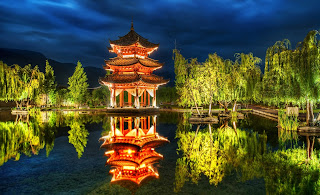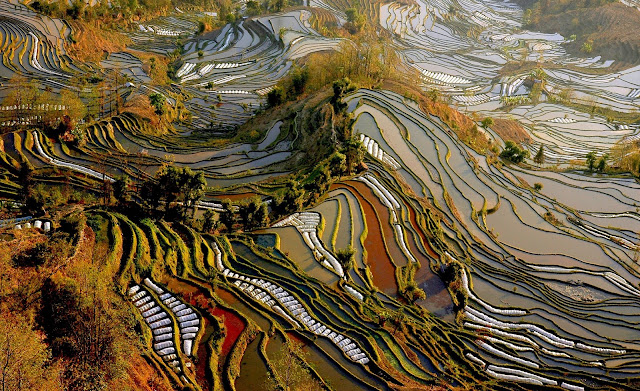| |||||||||||||||||||||||
Wednesday, January 15, 2014
Xinjiang - what to see?
http://www.toptrip.cc/destination/province/xinjiang.htm
A view of China through a foreigner's eye
http://traveladventureeverywhere.blogspot.sg/2013/08/china-voyage-to-china-asia.html
 Antique yet up-to-the-minute, familiar yet unrecognisable, outwardly urban but quintessentially rural, conservative yet path-breaking, space-age but old-fashioned, China is a land of mesmerising and eye-opening contradictions.
Antique yet up-to-the-minute, familiar yet unrecognisable, outwardly urban but quintessentially rural, conservative yet path-breaking, space-age but old-fashioned, China is a land of mesmerising and eye-opening contradictions.
 Out-of-This-World FlavoursChina is famously fixated with food but do yourself a favour and exchange your meagre local Chinatown menu for the lavish Middle Kingdom cookbook. Wolf down Peking duck, size up a sizzling lamb kebab inKāifēng or gobble down a bowl of Lánzhōu noodles on the Silk Road. SpicyHúnán food really raises the temperature but find time for momo (boiled dumplings), tsampa (roasted barley flour porridge) and other titbits from Tibet. Impress your friends as you gānbēi (down-in-one) the local firewater, sip a frozen daiquiri in a slick Běijīng bar or survey the Shànghǎi skyline through a raised cocktail glass. Second to none, the never-ending culinary adventure is possibly the most enticing aspect of Middle Kingdom travel and you'll come back from China with highly stimulated taste buds and much-cherished gastronomic memories.
Out-of-This-World FlavoursChina is famously fixated with food but do yourself a favour and exchange your meagre local Chinatown menu for the lavish Middle Kingdom cookbook. Wolf down Peking duck, size up a sizzling lamb kebab inKāifēng or gobble down a bowl of Lánzhōu noodles on the Silk Road. SpicyHúnán food really raises the temperature but find time for momo (boiled dumplings), tsampa (roasted barley flour porridge) and other titbits from Tibet. Impress your friends as you gānbēi (down-in-one) the local firewater, sip a frozen daiquiri in a slick Běijīng bar or survey the Shànghǎi skyline through a raised cocktail glass. Second to none, the never-ending culinary adventure is possibly the most enticing aspect of Middle Kingdom travel and you'll come back from China with highly stimulated taste buds and much-cherished gastronomic memories.
 Stupendous SceneryChina is vast. Off-the-scale massive. And you've just got to get outside: island-hop in Hong Kong, gaze out over the epic grasslands of Inner Mongolia or squint up at the mind-blowing peaks of the Himalayas. Trek your way around Tiger Leaping Gorge or cycle between the fairy-tale karst pinnacles of Yángshuò. Ponder the desiccated enormity of the Taklamakan Desert or swoon at Huángshān's preternatural mists. Become entranced by theYuányáng Rice Terraces of Yúnnán, size up the awesome sand dunes ofDūnhuáng, hike your way around the exquisite landscape of Déhāng or, when your energy fails you, flake out for a tan on the distant beaches of Hǎinán island.
Stupendous SceneryChina is vast. Off-the-scale massive. And you've just got to get outside: island-hop in Hong Kong, gaze out over the epic grasslands of Inner Mongolia or squint up at the mind-blowing peaks of the Himalayas. Trek your way around Tiger Leaping Gorge or cycle between the fairy-tale karst pinnacles of Yángshuò. Ponder the desiccated enormity of the Taklamakan Desert or swoon at Huángshān's preternatural mists. Become entranced by theYuányáng Rice Terraces of Yúnnán, size up the awesome sand dunes ofDūnhuáng, hike your way around the exquisite landscape of Déhāng or, when your energy fails you, flake out for a tan on the distant beaches of Hǎinán island.
Things To Do
Hotels
Need To Know
Tips & Articles
Images & Video










China ( 中國 ). A voyage to China, Asia.
 Antique yet up-to-the-minute, familiar yet unrecognisable, outwardly urban but quintessentially rural, conservative yet path-breaking, space-age but old-fashioned, China is a land of mesmerising and eye-opening contradictions.
Antique yet up-to-the-minute, familiar yet unrecognisable, outwardly urban but quintessentially rural, conservative yet path-breaking, space-age but old-fashioned, China is a land of mesmerising and eye-opening contradictions.
Awe-Inspiring AntiquityChina may be modernising at a head-spinning pace, but the slick skyscrapers, Lamborghini showrooms and Maglev trains are just eye-catching but wafer-thin gift-wrapping. Let's face it: the world's oldest continuous civilisation is bound to pull an artefact or two out of its hat. Travel selectively around China and you can quickly tap into a rich seam of antiquity: ponder the legends and myths of the Forbidden City, rediscover your sense of wonder on the Great Wall or attempt to fathom the timeless expressions of the silent Terracotta Warriors.
 Submit to the unique charms ofPíngyáo– China's best preserved walled town – or get a glimpse of Nirvana at the serene Mògāo Caves outside Dūnhuáng. Meander among the historic villages ofWùyuán, wake with the cock crow in an ancient Hakka roundhouse or join well-dressed Tibetan pilgrims on their circuitous kora around Labrang monastery.
Submit to the unique charms ofPíngyáo– China's best preserved walled town – or get a glimpse of Nirvana at the serene Mògāo Caves outside Dūnhuáng. Meander among the historic villages ofWùyuán, wake with the cock crow in an ancient Hakka roundhouse or join well-dressed Tibetan pilgrims on their circuitous kora around Labrang monastery.
 Submit to the unique charms ofPíngyáo– China's best preserved walled town – or get a glimpse of Nirvana at the serene Mògāo Caves outside Dūnhuáng. Meander among the historic villages ofWùyuán, wake with the cock crow in an ancient Hakka roundhouse or join well-dressed Tibetan pilgrims on their circuitous kora around Labrang monastery.
Submit to the unique charms ofPíngyáo– China's best preserved walled town – or get a glimpse of Nirvana at the serene Mògāo Caves outside Dūnhuáng. Meander among the historic villages ofWùyuán, wake with the cock crow in an ancient Hakka roundhouse or join well-dressed Tibetan pilgrims on their circuitous kora around Labrang monastery. Out-of-This-World FlavoursChina is famously fixated with food but do yourself a favour and exchange your meagre local Chinatown menu for the lavish Middle Kingdom cookbook. Wolf down Peking duck, size up a sizzling lamb kebab inKāifēng or gobble down a bowl of Lánzhōu noodles on the Silk Road. SpicyHúnán food really raises the temperature but find time for momo (boiled dumplings), tsampa (roasted barley flour porridge) and other titbits from Tibet. Impress your friends as you gānbēi (down-in-one) the local firewater, sip a frozen daiquiri in a slick Běijīng bar or survey the Shànghǎi skyline through a raised cocktail glass. Second to none, the never-ending culinary adventure is possibly the most enticing aspect of Middle Kingdom travel and you'll come back from China with highly stimulated taste buds and much-cherished gastronomic memories.
Out-of-This-World FlavoursChina is famously fixated with food but do yourself a favour and exchange your meagre local Chinatown menu for the lavish Middle Kingdom cookbook. Wolf down Peking duck, size up a sizzling lamb kebab inKāifēng or gobble down a bowl of Lánzhōu noodles on the Silk Road. SpicyHúnán food really raises the temperature but find time for momo (boiled dumplings), tsampa (roasted barley flour porridge) and other titbits from Tibet. Impress your friends as you gānbēi (down-in-one) the local firewater, sip a frozen daiquiri in a slick Běijīng bar or survey the Shànghǎi skyline through a raised cocktail glass. Second to none, the never-ending culinary adventure is possibly the most enticing aspect of Middle Kingdom travel and you'll come back from China with highly stimulated taste buds and much-cherished gastronomic memories. Stupendous SceneryChina is vast. Off-the-scale massive. And you've just got to get outside: island-hop in Hong Kong, gaze out over the epic grasslands of Inner Mongolia or squint up at the mind-blowing peaks of the Himalayas. Trek your way around Tiger Leaping Gorge or cycle between the fairy-tale karst pinnacles of Yángshuò. Ponder the desiccated enormity of the Taklamakan Desert or swoon at Huángshān's preternatural mists. Become entranced by theYuányáng Rice Terraces of Yúnnán, size up the awesome sand dunes ofDūnhuáng, hike your way around the exquisite landscape of Déhāng or, when your energy fails you, flake out for a tan on the distant beaches of Hǎinán island.
Stupendous SceneryChina is vast. Off-the-scale massive. And you've just got to get outside: island-hop in Hong Kong, gaze out over the epic grasslands of Inner Mongolia or squint up at the mind-blowing peaks of the Himalayas. Trek your way around Tiger Leaping Gorge or cycle between the fairy-tale karst pinnacles of Yángshuò. Ponder the desiccated enormity of the Taklamakan Desert or swoon at Huángshān's preternatural mists. Become entranced by theYuányáng Rice Terraces of Yúnnán, size up the awesome sand dunes ofDūnhuáng, hike your way around the exquisite landscape of Déhāng or, when your energy fails you, flake out for a tan on the distant beaches of Hǎinán island.
Ready to go?
PlacesThings To Do
Hotels
Need To Know
Tips & Articles
Images & Video










Friday, January 3, 2014
Shatuo Rulers in China
During the Ming Dynasty (1368–1644), a Ming emperor conferred seven surnames upon the Jews, by which they are identifiable today: Ai (艾),Shi (石), Gao (高), Jin (金), Li (李), Zhang (張), and Zhao (趙); sinofications of the original seven Jewish clan's family names: Ezra, Shimon, Cohen, Gilbert, Levy, Joshua, and Jonathan, respectively.[18][19] Interestingly, two of these: Jin and Shi are the equivalent of common Jewish names in the west: Gold and Stone.[20][21]http://en.wikipedia.org/wiki/History_of_the_Jews_in_China
Shatuo rulers are families of surname Li, Shi, Liu during these eras below. Li are Levy and we know from history that they come from Central Asia.
Category:Shatuo rulers
From Wikipedia, the free encyclopedia
The Shatuo (Chinese: 沙陀; pinyin: shātuó or Chinese: 沙陀突厥; pinyin: shātuó tūjué, also: Shato, Sha-t'o, Sanskrit Sart [1]) were a Turkic tribe that heavily influenced northern Chinese politics from the late ninth century through the tenth century. They are noted for founding 3 of the 5 dynasties and 1 of the kingdoms during the Five Dynasties and Ten Kingdoms period.
Subscribe to:
Comments (Atom)













